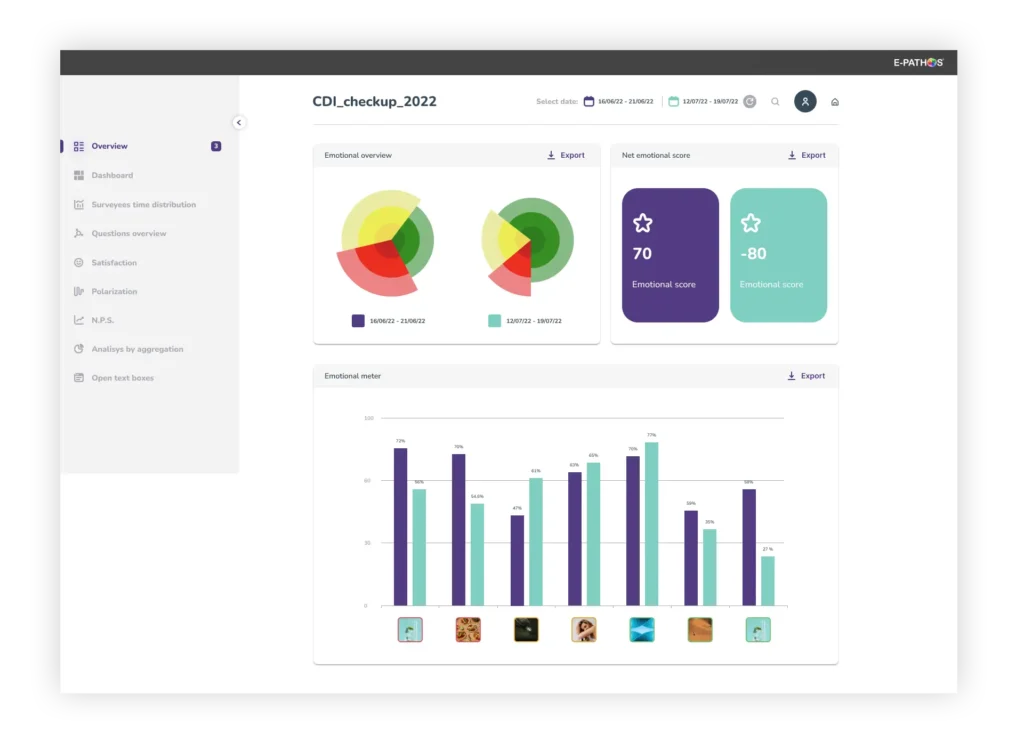When it comes to customer experience management, the first questions we ask ourselves are: “What is the main KPI?”, “Which indicator should we look at?”, “Which one is the best?”
In reality, the answers are not always clear-cut and sometimes the oversimplification of specific KPIs leads to a loss of detail, whereas a successful CX is all about the details. Certainly, more KPIs are needed to delve deep into the data and gain high-quality insights.
The Net Promoter Score (NPS) is a widely recognised and highly favoured metric that measures the quality of a relationship and, consequently, customer loyalty in a straightforward and effective manner.
Let’s do a little recap.
What is the Net Promoter Score
The Net Promoter Score (NPS) is a straightforward yet powerful tool to assess customer satisfaction and loyalty. It is based on a single key question: “On a scale of 0 to 10, how likely are you to recommend our company/product/service to a friend or colleague?” Based on the responses, customers are divided into three groups: promoters, passives and detractors.
Promoters (score of 9-10) are enthusiastic and loyal customers who hold high regard for your company and are likely to recommend it to others. They play a significant role in generating positive word-of-mouth. They are often “loyal” and can bring in new customers.
• Passives (score of 7-8) are satisfied but not overly enthusiastic customers. They are less likely to recommend your company and may be swayed by competing offers or better experiences.
• Detractors (score of 0-6) are dissatisfied or disappointed customers who could harm your reputation by spreading negative word-of-mouth. They are a red flag that must be addressed immediately in order to fix their problems and improve the customer experience.
Why calculate the Net Promoter Scores: what are the benefits?
The Net Promoter Score (NPS) is an extremely popular metric. It is important for companies seeking to enhance their customer experience and achieve long-term success.
• It helps to measure customer loyalty. The NPS is a clear and immediate indicator of customer loyalty. Identifying promoters allows companies to spot customers who are most likely to spread positive word-of-mouth and attract new customers. Simultaneously, recognising detractors enables addressing their concerns and potentially converting them into promoters.
• It predicts the success of a company. It is a predictive tool that can assist you – as part of a well-structured CX – in evaluating the future success of your company. Satisfied and loyal customers tend to generate a steady flow of business and have a higher long-term value.
• It identifies potential areas for improvement. When combined with feedback from detractors and customer comments, the NPS helps pinpoint problem areas or shortcomings that might negatively affect customer satisfaction. This gives you the opportunity to conduct more in-depth analyses in order to seize opportunities and set priorities.
• It keeps track of performance over time. Regular use of the NPS allows you to monitor your company’s performance over time. You can identify changes or trends in customer experience and adjust your strategies accordingly.
Having this data, especially if not isolated, allows you to develop a CX culture inside your company and communicate effectively with C-LEVEL personnel.
But why go further?
Emotions have become today’s markers of experience. When we recall an experience, we inevitably link it to an emotion. We asked ourselves how emotions could be measured, captured and converted into data. In our opinion, through images.
Measure THE EMOTIONAL EXPERIENCE you generate with E-PATHOS’S NET EMOTIONAL SCORE
E-Pathos distinguishes itself in the field of feedback management not only by collecting high-quality data in a timely manner but also by introducing an innovative methodology of measuring emotions using images to elicit responses.
Our surveys listen to the emotions associated with each individual touchpoint. Moreover, we measure a summary KPI of the emotional experience by considering all the responses generated by the survey, moving beyond a single-question approach like the NPS.
How is the NET EMOTIONAL SCORE (NES) constructed?
The images summarising the answers to experience-related questions represent an emotional experience, which can be traced back to the 16 basic emotions.
The emotional experience is categorised as follows:
- Red: negative emotions of varying intensity that indicate unpleasant experiences that are likely to result in negative word-of-mouth (e.g. irritation, disappointment, anger)
- Yellow: critical emotions that require attention. The relationship is less stable, and there is more room for contemplating alternative solutions (e.g. apprehension, aggression, annoyance, boredom, unease)
- Green: highly positive emotions such as happiness, optimism, serenity, and trust.
You can get a summary of the emotional experience related to all questions and calculate an indicator by subtracting the percentage of GREEN emotions from the percentage of RED emotions.

Unlike the traditional Net Promoter Score (NPS), the Net Emotional Score focuses on how customers and employees feel about a company, its products or services. This method recognises the importance of emotions in the overall experience and offers a more comprehensive perspective for evaluating the emotional bond between a company and its audience.
E-Pathos uses interactive surveys that are enriched with images and videos to capture the emotions and feelings of respondents. This engaging methodology fosters more authentic and profound feedback, as emotions play a crucial role in purchasing decisions and interactions with the company
Using E-Pathos to collect feedback allows you to:
• Understand the emotions of your customers. The inclusion of images and videos in E-Pathos surveys helps you grasp the emotions of your customers. You can learn how your customers feel about your company, products or services and better understand the emotional factors that influence their decisions.
•Measure the emotional connection. The Net Emotional Score allows you to measure the emotional connection between your company and its audience. You can assess the strength of positive or negative emotions that customers have towards your brand and seek to strengthen positive connections.
•Involve employees. The Net Emotional Score considers not only customers but also employees. E-PATHOS allows you to engage your employees through surveys that reveal their feelings and attitudes towards work and company culture. This enables you to have a deeper understanding of their well-being and to create a more satisfying and productive work environment.
E-PATHOS is committed to providing advanced tools for measuring the emotional experiences of both customers and employees. With the Net Emotional Score, you can gain a more comprehensive understanding of the customer experience, enabling you to make decisions based on higher quality and more detailed data.
Conclusion
With E-PATHOS, you can measure the NPS and NES on a daily basis, using video surveys that investigate all stages of the Customer Journey in order to learn, measure and improve.
In a world increasingly focused on the customer experience, E-PATHOS stands out as the ideal partner for companies seeking to measure and strengthen the emotional bond with their audience. With the Net Emotional Score and innovative interactive surveys, we are ready to revolutionise your perception of feedback management.
It’s not only about obtaining points or standard responses. It’s about evoking genuine emotions, understanding profound motivations and creating authentic connections.
E-PATHOS allows you to transcend mere numbers, to dive into the world of emotions and build enduring relationships with both customers and employees.










